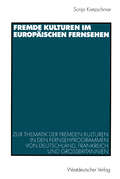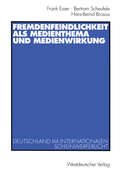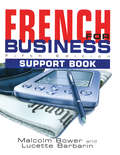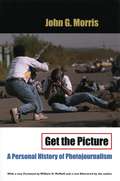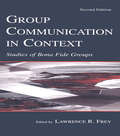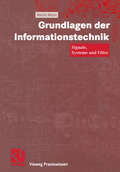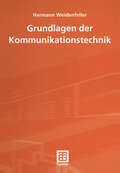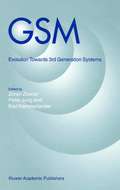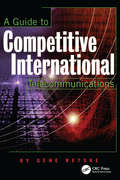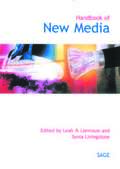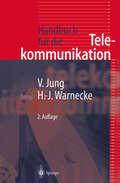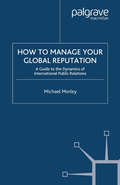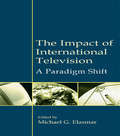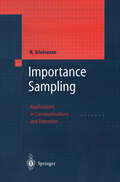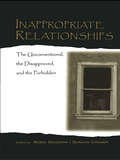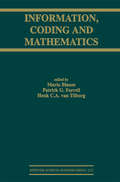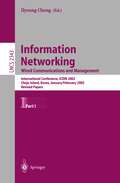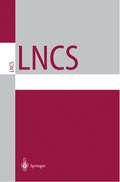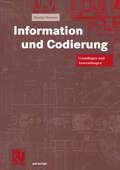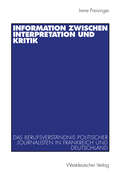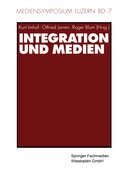- Table View
- List View
Fremde Kulturen im europäischen Fernsehen: Zur Thematik der fremden Kulturen in den Fernsehprogrammen von Deutschland, Frankreich und Großbritannien
by Sonja KretzschmarWie, und in welcher Form thematisiert das Fernsehen in Europa fremde Kulturen? Am Beispiel der Länder Großbritannien, Frankreich und Deutschland untersucht die Autorin das bestehende Fernsehprogramm, wertet Zuschauerzahlen aus und führt Intensivinterviews mit Filmemachern und Programmverantwortlichen der drei Länder.
Fremdenfeindlichkeit als Medienthema und Medienwirkung: Deutschland im internationalen Scheinwerferlicht
by Frank Esser Bertram Scheufele Hans-Bernd BrosiusDieser Band führt einerseits die Publikation "Eskalation durch Berichterstattung" von Brosius und Esser (1995) inhaltlich weiter. Andererseits gehen die Autoren in theoretischer, methodischer und ländervergleichender Hinsicht völlig neue Wege und untersuchen fünf verschiedene Effekttypen. Der Band zeigt die vielfältige Bedeutung der Massenmedien für das soziale Problem der Fremdenfeindlichkeit auf.
French for Business: Students Book, 5th Edition (French For Business Ser.)
by Lucette Barbarin Malcolm BowerFirst published in 2002. Routledge is an imprint of Taylor & Francis, an informa company.
French for Business: Students Book, 5th Edition
by Lucette Barbarin Malcolm BowerFirst published in 2002. Routledge is an imprint of Taylor & Francis, an informa company.
From QoS Provisioning to QoS Charging: Third COST 263 International Workshop on Quality of Future Internet Services, QofIS 2002, and Second International Workshop on Internet Charging and QoS Technologies, ICQT 2002, Zurich, Switzerland, October 16-18, 2002, Proceedings (Lecture Notes in Computer Science #2511)
by Burkhard Stiller Michael Smirnow Martin Karsten Peter ReichlThis volume of the Lecture Notes in Computer Science series contains the set of papers accepted for publication at the colocated QofIS/ICQT 2002 workshops, i.e. the 3rd COST Action 263 International Workshop on Quality of future Internet Services (QofIS) and the 2nd International Workshop on Internet Charging and QoS Technology (ICQT), both of which took place at the ETH Zric h, Switzerland, hosted by the Computer Engineering and Networking Laboratory, TIK. QofIS 2002 was the third in a series of highly successful technical workshops and meetings on Internet services within the framework of the COST Action 263 Q uality of future Internet Services , following previous events in Berlin, Germany in 2000 and in Coimbra, Portugal in 2001. ICQT 2002 was the follow-up to a vivid and extremely well-attended workshop on Internet economics and charging technology that took place within the framework of the Annual Meeting of the German Society for Computer Science (GI) and the Austrian Computer Society in 2001 in Vienna, Austria.
Get the Picture: A Personal History of Photojournalism
by John G. MorrisHow do photojournalists get the pictures that bring us the action from the world's most dangerous places? How do picture editors decide which photos to scrap and which to feature on the front page? Find out in Get the Picture, a personal history of fifty years of photojournalism by one of the top journalists of the twentieth century. John G. Morris brought us many of the images that defined our era, from photos of the London air raids and the D-Day landing during World War II to the assassination of Robert Kennedy. He tells us the inside stories behind dozens of famous pictures like these, which are reproduced in this book, and provides intimate and revealing portraits of the men and women who shot them, including Robert Capa, Henri Cartier-Bresson, and W. Eugene Smith. A firm believer in the power of images to educate and persuade, Morris nevertheless warns of the tremendous threats posed to photojournalists today by increasingly chaotic wars and the growing commercialism in publishing, the siren song of money that leads editors to seek pictures that sell copies rather than those that can change the way we see the world.
Group Communication in Context: Studies of Bona Fide Groups
by Larry R. FreyThe study of group communication has never been more critical, as recent national and international events point to the fragility of group life. An emerging perspective, the bona fide group perspective, offers hope for improving group communication, for it recognizes that any group--a family, community group, expedition team, social support group, organizational work group, interorganizational collaboration, or international team--must be studied and understood within the multiple contexts in which it is embedded and that significantly affects who is considered to be part of a group, what occurs within that group, and how that group interacts with other groups. In the second edition of his award-winning volume, editor Lawrence R. Frey showcases original research studies conducted on and about communication in bona fide groups, demonstrating the conceptual promise of the bona fide group perspective as realized in research practice. Divided into six sections, the chapters cover a wide range of new or relatively understudied groups--including youth community groups, Internet support groups, climbing expedition groups, families, neighborhoods, and school boards--and demonstrate the wealth of methodological approaches that can be used to study bona fide group communication--including survey methods, interviews, textual analysis, content analysis, participant observation, and discourse analysis. Group Communication in Context: Studies of Bona Fide Groups, Second Edition shows that the bona fide group perspective has the power to transform our thinking about groups and group communication and, in time, the practices in which groups and group members engage. The volume is intended for use in group communication courses, as well as a reference for group scholars. It is also appropriate for classes in psychology, social work, counseling, sociology, anthropology, and related disciplines.
Group Communication in Context: Studies of Bona Fide Groups (Lea's Communication Ser.)
by Lawrence R. FreyThe study of group communication has never been more critical, as recent national and international events point to the fragility of group life. An emerging perspective, the bona fide group perspective, offers hope for improving group communication, for it recognizes that any group--a family, community group, expedition team, social support group, organizational work group, interorganizational collaboration, or international team--must be studied and understood within the multiple contexts in which it is embedded and that significantly affects who is considered to be part of a group, what occurs within that group, and how that group interacts with other groups. In the second edition of his award-winning volume, editor Lawrence R. Frey showcases original research studies conducted on and about communication in bona fide groups, demonstrating the conceptual promise of the bona fide group perspective as realized in research practice. Divided into six sections, the chapters cover a wide range of new or relatively understudied groups--including youth community groups, Internet support groups, climbing expedition groups, families, neighborhoods, and school boards--and demonstrate the wealth of methodological approaches that can be used to study bona fide group communication--including survey methods, interviews, textual analysis, content analysis, participant observation, and discourse analysis. Group Communication in Context: Studies of Bona Fide Groups, Second Edition shows that the bona fide group perspective has the power to transform our thinking about groups and group communication and, in time, the practices in which groups and group members engage. The volume is intended for use in group communication courses, as well as a reference for group scholars. It is also appropriate for classes in psychology, social work, counseling, sociology, anthropology, and related disciplines.
Grundlagen der Informationstechnik: Signale, Systeme und Filter (Vieweg Praxiswissen)
by Martin MeyerDieses Buch bietet eine leicht verständliche Darstellung der theoretischen Grundlagen der analogen und digitalen Signalverarbeitung. So kann es sowohl zur Lösung von Standardproblemstellungen als auch für einen Einstieg in weiterführende Literatur herangezogen werden. Es ergänzt damit sinnvoll die zu diesem Thema bereits erschienenen Bücher.
Grundlagen der Kommunikationstechnik (Leitfaden der Elektrotechnik)
by Hermann WeidenfellerEin vollständiger, kompakter und verständlicher Überblick über das gesamte Gebiet der Nachrichtentechnik, angefangen von der Informationstheorie, der Theorie der Signale und Systeme über Netzwerke, Hochfrequenzleitungen, Antennen, Lichtwellenleiter, optische Sende- und Empfangselemente hin zur analogen und digitalen Nachrichtenübertragung, Codierung und Vermittlungstechnik.
GSM: Evolution towards 3rd Generation Systems
by Peter Jung Karl Kammerlander Z. ZvonarThe Global System for Mobile Communication (GSM) is undoubtedly the most successful second generation digital mobile radio system. One of the key factors for this exceptional performance is the constant evolution of the GSM systems and its derivatives DCS-1800 and PCS-1900. The objective of the book is to address new concepts in the GSM system, dealing with both standardised features as well as theoretically and technologically feasible improvements, which contribute to evolutionary changes in general. Dynamic evolution of GSM presents a platform for the Universal Mobile Telecommunication System (UMTS) introduction and major trends in UMTS development will be addressed in this book, in particular progress towards new radio interface. The book is the collection of individual contributions from a number of authors. The intention of the editors was to gather the most prominent specialist in the GSM area. Ongoing efforts in GSM standardisation are focused on Phase 2+ with items planned to be added gradually on demand. Being mostly independent of each other, each of them could be introduced with little impact on the rest of the system. Speech remains the prime service of cellular systems with ongoing work on spectral efficiency taking into account the trade-off between cost of the system and transmission quality. Most notable result from novel speech service implementations is the introduction of new Enhanced Full Rate (EFR) speech coder. International railway organisation (Union Internationale des Chemins de Fer - UIC) has influenced the development of Advanced Speech Call Items (ASCI).
A Guide to Competitive International Telecommunications
by Gene RetskeThis book provides vital information on the business, technical, legal and practical considerations in the 'New Telecom World Order'. The book offers a complete overview of the new technologies and marketing methods that new competitors are using around t
Handbook of New Media: Social Shaping and Consequences of ICTs (PDF)
by Sonia Livingstone Leah A Lievrouw'Selected contributions are all of high quality and do indeed contribute to the editors goal; synthesis combined with new horizons, cross-disciplinary approaches combine with state of the art description. This makes the Handbook of New Media de facto required reading for anybody involved in new media and its understanding. . . . The aim of this book was ambitious and the size of the book is impressive but the result is there, a handbook of new media, which will remain a key referance in new media research for some considerable time' - Learning Media Technology `A landmark volume that provides a foundation stone for a new subject - the study of new media. It is stunningly well-edited, offering a very high standard of original contributions in a skilfully orchestrated and organised textbook' - James Curran, Goldsmiths College, University of London `This is the first major review of interactive technologies and their cultural and social context. This is more than a welcome addition to one's library; it is the authoritative overview of international research perspectives on interactive media technologies by leading scholars around the world' - Ellen Wartella, University of Texas, Austin `The Handbook of New Media is a landmark for the study of information and communication technologies within the field of communication. Its international team of editors and authors has brought together insights gained from over two decades of scholarly research. This indispensable reference demonstrates an increased maturity and stature for "new media" research within the field' - William H Dutton, University of Southern California `A truly comprehensive and authoritative volume. This Handbook will be an absolutely essential text for anyone concerned with social aspects of the new media' - Kevin Robins, Goldsmiths College, University of London The past 20 years have seen remarkable growth in research and scholarship addressing new information and communication technologies and their social contexts. Often called `new media' research, this growing field is both international and interdisciplinary. The Handbook of New Media sets out boundaries of new media research and scholarship and provides a definitive statement of the current state-of-the-art of the field. Divided into six sections covering major problem areas of research, the Handbook includes an introductory essay by the editors and a concluding essay by Ron Rice. Each chapter, written by an internationally renowned scholar, provides a review of the most significant social research findings and insights. This Handbook will be an indispensable volume on the personal bookshelves of all scholars working in the area, required reading for graduate students, a reference work for established researchers and newcomers to new media scholarship, and an intellectual benchmark for the field.
Handbuch für die Telekommunikation
by Volker Jung Hans-Jürgen WarneckeDer Standard nun in aktueller Neuauflage!o Telekommunikation und Multimedia für Ingenieure, Informatiker und Kaufleuteo Herausragendes Expertenwissen praxisgerecht aufbereiteto Allgemeingültige und verbindliche Richtlinien für die TelekommunikationsbrancheIhr direkter Weg zu aktuellem Anwenderwissen!
How to Manage Your Global Reputation: A Guide to the Dynamics of International Public Relations
by M. MorleyThis is an updated and revised edition of the author's successful and ground breaking book on international public relations and global reputation. Michael Morley has counselled clients of the world's largest corporations. This book shows how to achieve a global reputation and why this makes a vital contribution to the survival and success of the corporation.
The Impact of International Television: A Paradigm Shift (Routledge Communication Series)
by Michael G. ElasmarFor several decades, cultural imperialism has been the dominant paradigm for conceptualizing, labeling, predicting, and explaining the effects of international television. It has been used as an unchallenged premise for numerous essays on the topic of imported television influence, despite the fact that the assumption of strong cultural influence is not necessarily reflected in the body of research that exists within this field of study. In The Impact of International Television: A Paradigm Shift, editor Michael G. Elasmar and his contributors challenge the dominant paradigm of cultural imperialism, and offer an alternative paradigm with which to evaluate international or crossborder message influence. In this volume, Elasmar has collected original research from leading scholars working in the area of crossborder media influence, and contributes his own meta-analysis to examine what research findings actually show on the influences of crossborder messages. The contributions included here illustrate points, such as: the contentions of cultural imperialism and the context in which its assumptions emerged and developed; the complexities of the relationship between exposure to foreign television and its subsequent effects on local audience members; the applicability of quantitative methods to a topic commonly tackled using argumentation, critical theory, and other qualitative approaches; and the difficulty of achieving strong and homogenous effects. In bringing together the work of independent researchers, The Impact of International Television: A Paradigm Shift bridges over 40 years of research efforts focused on imported television influence, the results of which, as a whole, challenge the de facto strong and homogenous effects assumed by those who support the paradigm of cultural imperialism. The volume sets a theory-driven agenda of research and offers an alternative paradigm for the new generation of researchers interested in international media effects. As such, the volume is intended for scholars, researchers, and students in international and intercultural communication, cross-cultural communication, mass communication, media effects, media and society, and related areas. It will also be of great interest to academics in international relations, cross-cultural and social psychology, intergroup and international relations, international public opinion, and peace studies.
The Impact of International Television: A Paradigm Shift (Routledge Communication Series)
by Michael G. ElasmarFor several decades, cultural imperialism has been the dominant paradigm for conceptualizing, labeling, predicting, and explaining the effects of international television. It has been used as an unchallenged premise for numerous essays on the topic of imported television influence, despite the fact that the assumption of strong cultural influence is not necessarily reflected in the body of research that exists within this field of study. In The Impact of International Television: A Paradigm Shift, editor Michael G. Elasmar and his contributors challenge the dominant paradigm of cultural imperialism, and offer an alternative paradigm with which to evaluate international or crossborder message influence. In this volume, Elasmar has collected original research from leading scholars working in the area of crossborder media influence, and contributes his own meta-analysis to examine what research findings actually show on the influences of crossborder messages. The contributions included here illustrate points, such as: the contentions of cultural imperialism and the context in which its assumptions emerged and developed; the complexities of the relationship between exposure to foreign television and its subsequent effects on local audience members; the applicability of quantitative methods to a topic commonly tackled using argumentation, critical theory, and other qualitative approaches; and the difficulty of achieving strong and homogenous effects. In bringing together the work of independent researchers, The Impact of International Television: A Paradigm Shift bridges over 40 years of research efforts focused on imported television influence, the results of which, as a whole, challenge the de facto strong and homogenous effects assumed by those who support the paradigm of cultural imperialism. The volume sets a theory-driven agenda of research and offers an alternative paradigm for the new generation of researchers interested in international media effects. As such, the volume is intended for scholars, researchers, and students in international and intercultural communication, cross-cultural communication, mass communication, media effects, media and society, and related areas. It will also be of great interest to academics in international relations, cross-cultural and social psychology, intergroup and international relations, international public opinion, and peace studies.
Importance Sampling: Applications in Communications and Detection
by Rajan SrinivasanThis research monograph deals with fast stochastic simulation based on im portance sampling (IS) principles and some of its applications. It is in large part devoted to an adaptive form of IS that has proved to be effective in appli cations that involve the estimation of probabilities of rare events. Rare events are often encountered in scientific and engineering processes. Their charac terization is especially important as their occurrence can have catastrophic consequences of varying proportions. Examples range from fracture due to material fatigue in engineering structures to exceedance of dangerous levels during river water floods to false target declarations in radar systems. Fast simulation using IS is essentially a forced Monte Carlo procedure designed to hasten the occurrence of rare events. Development of this simu lation method of analysis of scientific phenomena is usually attributed to the mathematician von Neumann, and others. Since its inception, MC simula tion has found a wide range of employment, from statistical thermodynamics in disordered systems to the analysis and design of engineering structures characterized by high complexity. Indeed, whenever an engineering problem is analytically intractable (which is often the case) and a solution by nu merical techniques prohibitively expensive computationally, a last resort to determine the input-output characteristics of, or states within, a system is to carry out a simulation.
Inappropriate Relationships: the Unconventional, the Disapproved, and the Forbidden (LEA's Series on Personal Relationships)
by Robin Goodwin Duncan CramerIn one of the great euphemisms of our time, an embattled President Clinton admitted to an "inappropriate relationship" with his White House intern, Monica Lewinsky. But what exactly is an "inappropriate relationship?" For that matter, what is an "appropriate relationship?" And how can an understanding of the rules of "appropriateness" help us understand personal relationships in our modern world? Contributors to this book discuss the personal boundaries and taboos of modern relationships. Together they examine the power struggles that can occur when individuals are involved in "inappropriate" relationships, and the ways individuals in such a relationship may attempt to buffer themselves against sanctions--or even embrace this relationship as an agent of social change. Representing work from a range of disciplines, this collection will appeal to scholars, researchers, students, and professionals working on relationships issues in areas across the social sciences, including those working in the fields of social psychology, family studies, social anthropology, cultural studies, and communication.
Information, Coding and Mathematics: Proceedings of Workshop honoring Prof. Bob McEliece on his 60th birthday (The Springer International Series in Engineering and Computer Science #687)
by Mario Blaum Patrick G. Farrell Henk C. A. Van TilborgInformation, Coding and Mathematics is a classic reference for both professional and academic researchers working in error-correction coding and decoding, Shannon theory, cryptography, digital communications, information security, and electronic engineering. The work represents a collection of contributions from leading experts in turbo coding, cryptography and sequences, Shannon theory and coding bounds, and decoding theory and applications. All of the contributors have individually and collectively dedicated their work as a tribute to the outstanding work of Robert J. McEliece. Information, Coding and Mathematics covers the latest advances in the widely used and rapidly developing field of information and communication technology.
Information Networking: Wired Communications and Management (Lecture Notes in Computer Science #2343)
by Ilyoung ChongThe papers comprising Vol. I and Vol. II were prepared for and presented at the International Conference on Information Networking 2002 (ICOIN 2002), which was held from January 30 to February 1, 2002 at Cheju Island, Korea. It was organized by the KISS (Korean Information Science Society) SIGIN in Korea, IPSJ SIG DPE (Distributed Processing Systems) in Japan, the ITRI (Industrial Technology Research Institute), and National Taiwan University in Taiwan. The papers were selected through two steps, refereeing and presentation review. We selected for the theme of the conference the motto “One World of Information Networking”. We did this because we believe that networking will transform the world into one zone, in spite of different ages, countries and societies. Networking is in the main stream of everyday life and affects directly millions of people around the world. We are in an era of tremendous excitement for professionals working in many aspects of the converging networking, information retailing, entertainment, and publishing companies. Ubiquitous communication and computing technologies are changing the world. Online communities, e commerce, e service, and distance learning are a few of the consequences of these technologies, and advanced networking will develop new applications and technologies with global impact. The goal is the creation of a world wide distributed computing system that connects people and appliances through wireless and high bandwidth wired channels with a backbone of computers that serve as databases and object servers. Thus, Vol.
Information Networking: International Conference, ICOIN 2002, Cheju Island, Korea, January 30 - February 1, 2002. Revised Papers. Part II (Lecture Notes in Computer Science #2344)
by Ilyoung ChongThe papers comprising Vol. I and Vol. II were prepared for and presented at the International Conference on Information Networking 2002 (ICOIN 2002), which was held from January 30 to February 1, 2002 at Cheju Island, Korea. It was organized by the KISS (Korean Information Science Society) SIGIN in Korea, IPSJ SIG DPE (Distributed Processing Systems) in Japan, the ITRI (Industrial Technology Research Institute), and National Taiwan University in Taiwan. The papers were selected through two steps, refereeing and presentation review. We selected for the theme of the conference the motto “One World of Information Networking”. We did this because we believe that networking will transform the world into one zone, in spite of different ages, countries and societies. Networking is in the main stream of everyday life and affects directly millions of people around the world. We are in an era of tremendous excitement for professionals working in many aspects of the converging networking, information retailing, entertainment, and publishing companies. Ubiquitous communication and computing technologies are changing the world. Online communities, e commerce, e service, and distance learning are a few of the consequences of these technologies, and advanced networking will develop new applications and technologies with global impact. The goal is the creation of a world wide distributed computing system that connects people and appliances through wireless and high bandwidth wired channels with a backbone of computers that serve as databases and object servers. Thus, Vol.
Information und Codierung: Grundlagen und Anwendungen (uni-script)
by Martin WernerDas Buch gibt eine fundierte Einführung in die Grundlagen und Methoden der Informationstechnik: technischer Informationsbegriff, Entropie, Quellencodierung, Informationskanal und Kanalcodierung. Zwei Schwerpunkte bilden dabei die Markov-Ketten zur Modellierung diskreter gedächtnisbehafteter Quellen und die zyklischen Codes, die in der Datenübertragung zur Fehlererkennung eingesetzt werden. Das Manuskript wurde für eine 4 Stunden Lehrveranstaltung für Studierende der Informations- und Kommunikationstechnik im 4. Semester an der FH Fulda entwickelt. Dem FH Studiengang gemäß wurde auf die in der Informationstheorie häufig gebrachte umfangreiche mathematische Beweisführung zugunsten eines Verständnisses der grundsätzlichen Ansätze und Zusammenhänge verzichtet. Bei der für den Leser bewusst überschaubar gehaltenen Auswahl der Themen und Beispiele wurde besonderer Wert auf eine kompakte Darstellung und die Verbindung zur Praxis gelegt.
Information zwischen Interpretation und Kritik: Das Berufsverständnis politischer Journalisten in Frankreich und Deutschland
by Irene PreisingerDer Vergleich zwischen Frankreich und Deutschland zeigt, dass in demokratischen Systemen politischer Journalismus unterschiedlich geregelt sein kann. Als Basisleistung der Information gilt links wie rechts des Rheins der Austausch zwischen politischer Führung und Öffentlichkeit. Aber mehr als 100 Interviews verdeutlichen, dass Redakteure meinungsführender Printmedien der beiden Länder dabei verschiedene Aspekte betonen. Beispielsweise nähern sich die einen dem angelsächsischen Modell des Journalismus, während die anderen sich wegorientieren. Auch der Fokus ist länderspezifisch: Information oszilliert zwischen Interpretation und Kritik.
Integration und Medien (Mediensymposium #7)
by Kurt Imhof Otfried Jarren Roger BlumBei aller Mannigfaltigkeit der sozialwissenschaftlichen Theorien lässt sich ein gemeinsamer Begriff ausmachen, der sämtliche Theorieschulen oder -schwärme kennzeichnet: die zentrale Bedeutung des Terminus Kommunikation. Im Licht dieser Fundamentalkategorie und unter dem Eindruck der mediengesellschaftlichen Entwicklungsdynamik rücken mehr und mehr die Interdependenz zwischen dem Mediensystem und anderen Teilsystemen ausdifferenzierter Gesellschaften in den Fokus der Diskussionen.
